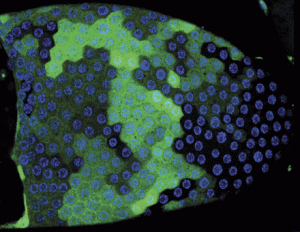Enter your address to receive notifications about new posts to your email.
-
Congratulations DeLill Nasser Award recipients!
GSA is pleased to announce the recipients of the DeLill Nasser Award for Professional Development in Genetics for Spring 2017. The award is given twice a year to graduate students and postdoctoral researchers to support attendance at meetings and laboratory courses. The award is named in honor of DeLill Nasser, a long-time GSA supporter and National Science…
-
GSA-Art: Adi Salzberg
GSA-Art features the creative works of scientists, particularly geneticists. Read more about the series from GSA President Stan Fields. If you would like to submit your own work or nominate someone else’s, please send an email GenesToGenomes@genetics-gsa.org with “GSA-Art” in the subject line. Adi Salzberg is an Associate Professor at the Technion-Israel Institute of Technology, where she studies PNS development in…
-
Beyond stressed-out: the hypoxic response
Deep within a tumor, sequestered from an adequate blood supply, a cancer cell grows and multiplies. Far beneath Earth’s surface, a microbe lives and thrives in similarly low-oxygen conditions. Generally, oxygen depletion causes serious distress to aerobic organisms—what allows these life forms to survive? The cellular response to hypoxia is massive. Hypoxia alters the expression…
-
Pathogenic yeast uniquely resists toxicity of aggregation-prone proteins
Misfolded proteins can be so toxic that they cause cell death. At least nine neurodegenerative disorders are caused by misfolded proteins with expanded stretches of glutamine residues (polyQ tracts), including the invariably fatal Huntington’s disease. But some organisms are resistant to the harmful effects of these proteins. In the January issue of G3, Leach et…
-
A modern look at ancient DNA
Well over 15,000 years ago, a man and a bear died in a cave in the Jura Mountains in modern-day Switzerland. That was the end of the story for millennia—until their remains were discovered in 1954 by researchers investigating the cave. Further work in the 1990s uncovered the fact that the man had, in fact,…
-
Enhancer-promoter distance is a potent modulator of gene expression
To boost transcription of a target gene, enhancer sequences must make contact with the gene’s promoter. This crucial meeting is mediated by interacting proteins and the formation of chromatin loops that bring distant enhancers and promoters together. Although it’s clear that enhancers increase transcription this way, the primary mechanisms by which an enhancer’s target genes…
-
Fruit fly feast: Preview of the Annual Drosophila Research Conference
Don’t miss out on this year’s Annual Drosophila Research Conference: The late abstract deadline is January 23, 2017 and the early registration discount ends February 3, 2017. Check out the fantastic lineup of invited speakers below! More details of the conference are available here, including details of special events like the PI Early Career Forum,…
-
Jeannie Lee appointed GSA Vice-President
The GSA Board of Directors is pleased to announce that Jeannie T. Lee (HHMI/Harvard University/Massachusetts General Hospital) has been appointed GSA Vice-President. Last year, Barbara J. Meyer (HHMI/University of California, Berkeley) was elected the 2017 Vice-President and 2018 President of the GSA Board of Directors. Unfortunately, Meyer will no longer be able to take on…
-
GSA-Art: Douglas Bishop
GSA-Art features the creative works of scientists, particularly geneticists. Read more about the series from GSA President Stan Fields. If you would like to submit your own work or nominate someone else’s, please send an email GenesToGenomes@genetics-gsa.org with “GSA-Art” in the subject line. Douglas Bishop is a professor in the Department of Radiation and Cellular Oncology and the Department of Molecular…
-
New in G3: chicken genome assembly, Drosophila co-CRISPR, and more
Check out the January issue of G3! Table of Contents Investigations The CgHaa1-Regulon Mediates Response and Tolerance to Acetic Acid Stress in the Human Pathogen Candida glabrata Ruben T. Bernardo, Diana V. Cunha, Can Wang, Leonel Pereira, Sónia Silva, Sara B. Salazar, Markus S. Schröder, Michiyo Okamoto, Azusa Takahashi-Nakaguchi, Hiroji Chibana, Toshihiro Aoyama, Isabel Sá-Correia,…
-
January GENETICS Highlights
Check out the January issue of GENETICS by looking at the highlights or the full table of contents! ISSUE HIGHLIGHTS This Month’s Centennial Articles The sustained impact of model organisms—in genetics and epigenetics, pp. 1-4 Nancy M. Bonini and Shelley L. Berger In this GENETICS Centennial commentary, Nancy M. Bonini and Shelley L. Berger reflect on the history of…







![By Kelvinsong (Own work) [CC BY 3.0], via Wikimedia Commons. (Modified)](https://s36063.pcdn.co/wp-content/uploads/2017/01/rsz_transcription_factors-300x163.png)




